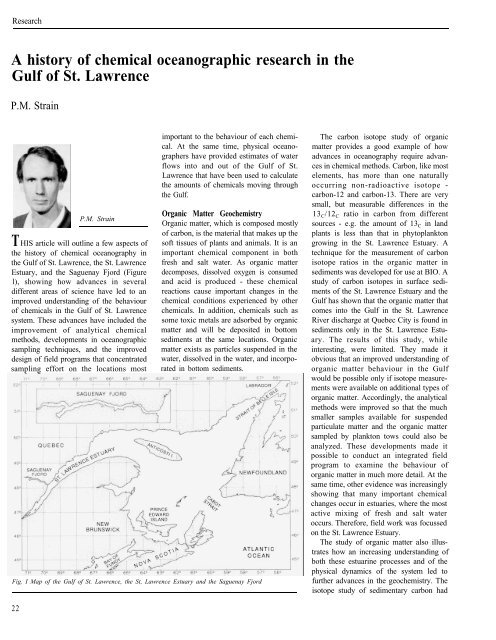SCIENCE REVIEW 1987 - Bedford Institute of Oceanography
SCIENCE REVIEW 1987 - Bedford Institute of Oceanography
SCIENCE REVIEW 1987 - Bedford Institute of Oceanography
You also want an ePaper? Increase the reach of your titles
YUMPU automatically turns print PDFs into web optimized ePapers that Google loves.
Research<br />
A history <strong>of</strong> chemical oceanographic research in the<br />
Gulf <strong>of</strong> St. Lawrence<br />
P.M. Strain<br />
P.M. Strain<br />
THIS article will outline a few aspects <strong>of</strong><br />
the history <strong>of</strong> chemical oceanography in<br />
the Gulf <strong>of</strong> St. Lawrence, the St. Lawrence<br />
Estuary, and the Saguenay Fjord (Figure<br />
l), showing how advances in several<br />
different areas <strong>of</strong> science have led to an<br />
improved understanding <strong>of</strong> the behaviour<br />
<strong>of</strong> chemicals in the Gulf <strong>of</strong> St. Lawrence<br />
system. These advances have included the<br />
improvement <strong>of</strong> analytical chemical<br />
methods, developments in oceanographic<br />
sampling techniques, and the improved<br />
design <strong>of</strong> field programs that concentrated<br />
sampling effort on the locations most<br />
important to the behaviour <strong>of</strong> each chemical.<br />
At the same time, physical oceanographers<br />
have provided estimates <strong>of</strong> water<br />
flows into and out <strong>of</strong> the Gulf <strong>of</strong> St.<br />
Lawrence that have been used to calculate<br />
the amounts <strong>of</strong> chemicals moving through<br />
the Gulf.<br />
Organic Matter Geochemistry<br />
Organic matter, which is composed mostly<br />
<strong>of</strong> carbon, is the material that makes up the<br />
s<strong>of</strong>t tissues <strong>of</strong> plants and animals. It is an<br />
important chemical component in both<br />
fresh and salt water. As organic matter<br />
decomposes, dissolved oxygen is consumed<br />
and acid is produced - these chemical<br />
reactions cause important changes in the<br />
chemical conditions experienced by other<br />
chemicals. In addition, chemicals such as<br />
some toxic metals are adsorbed by organic<br />
matter and will be deposited in bottom<br />
sediments at the same locations. Organic<br />
matter exists as particles suspended in the<br />
water, dissolved in the water, and incorporated<br />
in bottom sediments.<br />
Fig. I Map <strong>of</strong> the Gulf <strong>of</strong> St. Lawrence, the St, Lawrence Estuary and the Saguenay Fjord<br />
22<br />
The carbon isotope study <strong>of</strong> organic<br />
matter provides a good example <strong>of</strong> how<br />
advances in oceanography require advances<br />
in chemical methods. Carbon, like most<br />
elements, has more than one naturally<br />
occurring non-radioactive isotope -<br />
carbon-12 and carbon-13. There are very<br />
small, but measurable differences in the<br />
13 C/12 C ratio in carbon from different<br />
sources - e.g. the amount <strong>of</strong> 13 C in land<br />
plants is less than that in phytoplankton<br />
growing in the St. Lawrence Estuary. A<br />
technique for the measurement <strong>of</strong> carbon<br />
isotope ratios in the organic matter in<br />
sediments was developed for use at BIO. A<br />
study <strong>of</strong> carbon isotopes in surface sediments<br />
<strong>of</strong> the St. Lawrence Estuary and the<br />
Gulf has shown that the organic matter that<br />
comes into the Gulf in the St. Lawrence<br />
River discharge at Quebec City is found in<br />
sediments only in the St. Lawrence Estuary.<br />
The results <strong>of</strong> this study, while<br />
interesting, were limited. They made it<br />
obvious that an improved understanding <strong>of</strong><br />
organic matter behaviour in the Gulf<br />
would be possible only if isotope measurements<br />
were available on additional types <strong>of</strong><br />
organic matter. Accordingly, the analytical<br />
methods were improved so that the much<br />
smaller samples available for suspended<br />
particulate matter and the organic matter<br />
sampled by plankton tows could also be<br />
analyzed. These developments made it<br />
possible to conduct an integrated field<br />
program to examine the behaviour <strong>of</strong><br />
organic matter in much more detail. At the<br />
same time, other evidence was increasingly<br />
showing that many important chemical<br />
changes occur in estuaries, where the most<br />
active mixing <strong>of</strong> fresh and salt water<br />
occurs. Therefore, field work was focussed<br />
on the St. Lawrence Estuary.<br />
The study <strong>of</strong> organic matter also illustrates<br />
how an increasing understanding <strong>of</strong><br />
both these estuarine processes and <strong>of</strong> the<br />
physical dynamics <strong>of</strong> the system led to<br />
further advances in the geochemistry. The<br />
isotope study <strong>of</strong> sedimentary carbon had



